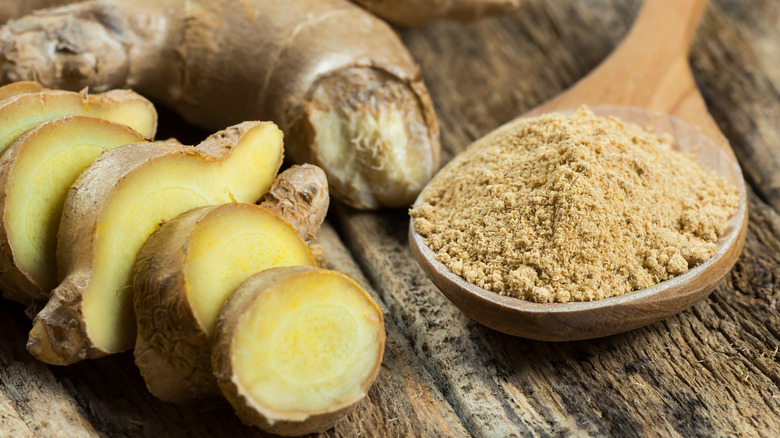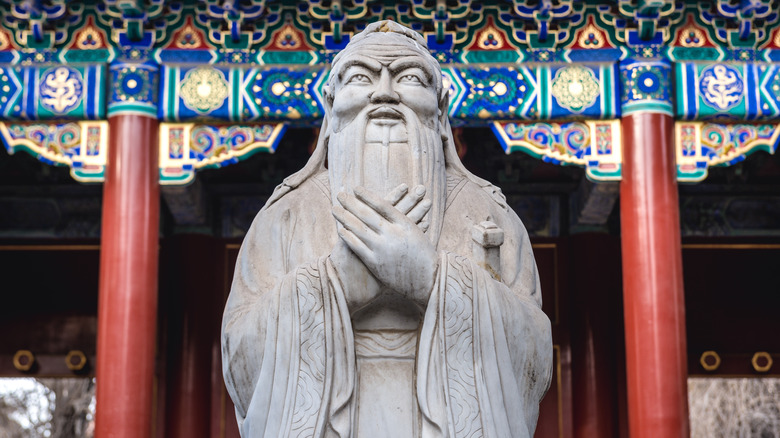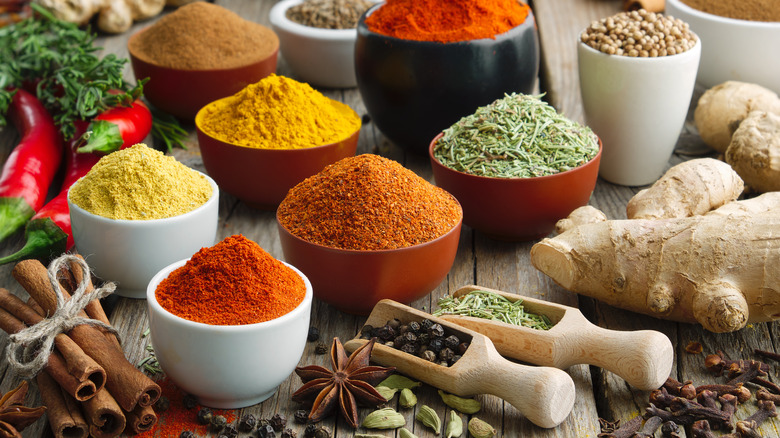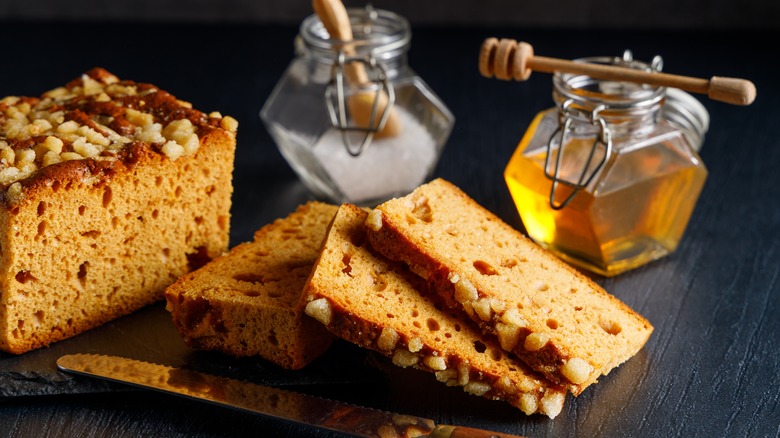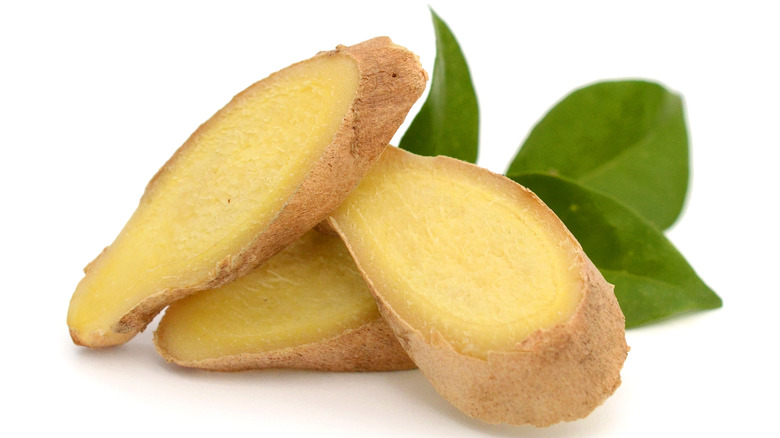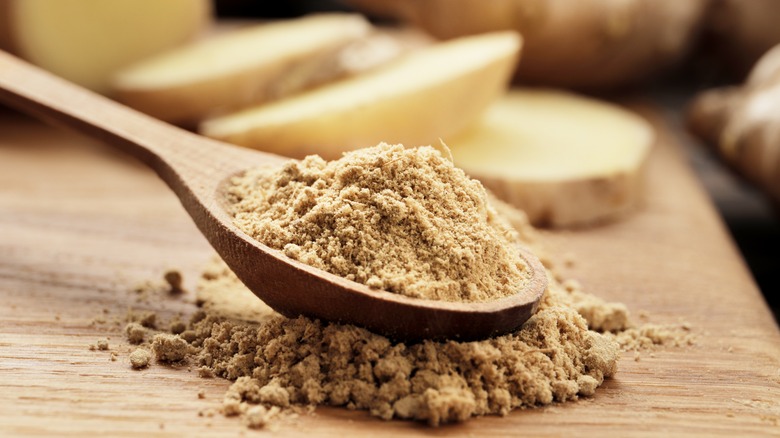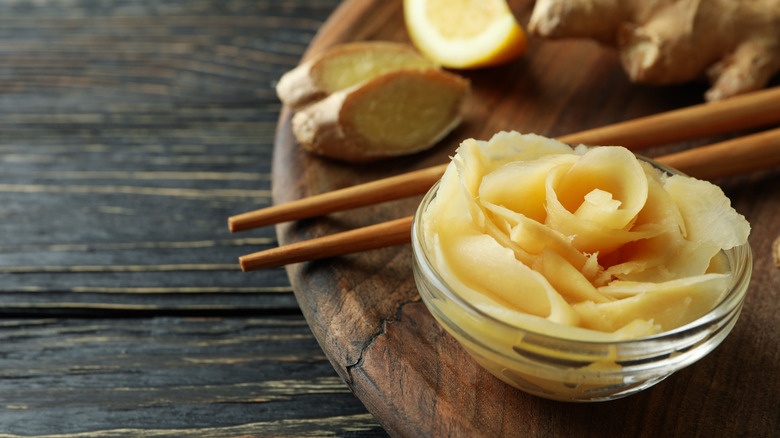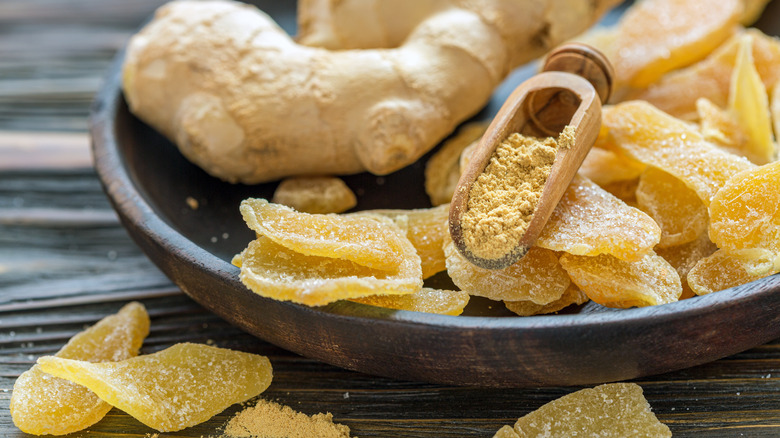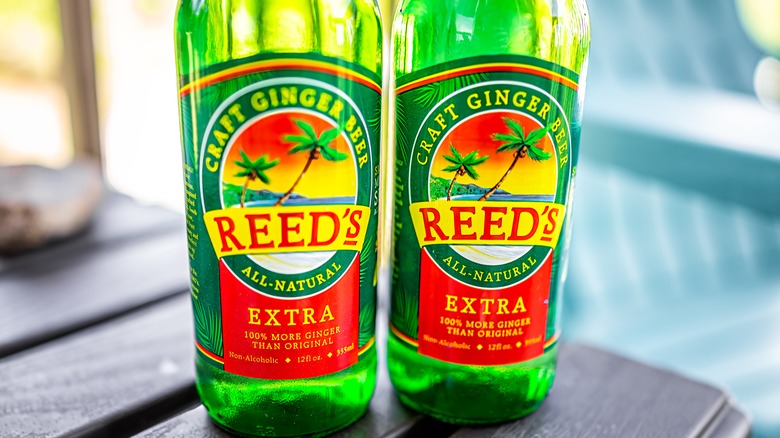Ginger: The Spice That Took Root Over 4,000 Years Ago
Culinary ginger — which so many of us find a little bit spicy, a little bit sweet, and exceedingly pleasing to the palate — comes from the rhizome of the Zingiber officinale plant. University of Madison-Wisconsin's Division of Horticulture explains that the fleshy rhizome we eat is neither the root nor shoot of the plant, but rather a stem that grows horizontally underground.
So, although ginger technically shouldn't be called a root (ginger rhizome just doesn't have the same ring to it), we're going to celebrate the spice known 'round the world for its distinct flavor profile as well as its scientifically confirmed herbal and medicinal properties. Per the National Institute of Health, an abundant supply of ketones called gingerols (31 compounds to be exact) account for the spice's aroma and health properties. Multiple studies have supported the longtime claims of ginger as an anti-inflammatory and digestive aid.
This wildly popular spice comes with a storied history that stretches back through many cultures and cuisines. The exact origins of what is now commonly called ginger (from the Middle English word gingivere) have not been revealed, but we'll explore the prevalence of the ancient root throughout history and the modern uses for today's home cooks.
China started using ginger around 4,000 years ago
Zingiber officinale originated in southern China, but the historical origins of ginger is cloudy at best because it was cultivated long before written records began. Some say ginger was used 7,000 years ago, which is unlikely, while others are more apt to say 5,000 even though some historians call into question China's reported 5,000-year-old history, says The China Project.
From written records, we know that Confucius wrote about ginger around 500 B.C. in his book the Lunyu (Analects). He even claimed it was a part of his every meal (via University of Iowa). And, much later in 1578, the spice was included in Li Shi-zhen's Compendium of Materia Medica known as the Ben Cao Gang Mu (via UNESCO). It seems the Chinese, since ancient times, have always thought of ginger as part food, part medicine.
Within traditional Chinese medicine (TCM), a practice that is at least 3,000 years old, ginger is called sheng-jian, notes Me & Qi. The spice is used in formulations to "harmonize the stomach." Ginger is considered a powerful antidote to morning sickness, seafood poisoning, hiccups, and the list goes on. TCM labels the taste of ginger as pungent and thus associates it with treating the lungs, spleen, and stomach. Research has shown that prescribing ginger can reduce glycemic indices in those with Type 2 diabetes as well as relieve symptoms of osteoarthritis and nausea affiliated with chemotherapy.
Ginger originated in India 3,000 years ago
From China, ginger traveled to India. Due to its odd shape, the 3,000 year old Sanskrit word for ginger is srngaveram, which translates to horn body (antlers). It also has an ancient Dravidian name, inchiver, per Fine Dining Lovers. These ancient words used to describe the root are some of the oldest words in culinary history. Just as in China, ginger in Indian culture is valued as both a food additive and a medicinal treatment, this time in the Ayurvedic tradition.
The Journal of Traditional and Complementary Medicine defines Ayurveda as a nature-based traditional system of medicine that is believed to have been started by Hindu philosophy in the 2nd Century B.C., who used powerful herbs. Chopra notes that, in Ayurveda, ginger is respected as the universal medicine, particularly revered as a digestive aid and respiratory reliever with antioxidant, anti-inflammatory, and anti-nausea properties.
In cuisine, ginger is commonly listed as adrak, its official name in Hindi, Punjabi, and Urdu, explains Secret Indian Recipe. You'll find it in a slew of delicious Indian dishes from curries to vindaloos to biryanis. The beauty of a meal like this vegetable korma recipe is that the spices taste incredible, they warm you up when the temperatures drop, and your body employs the medicinal benefits of them at the same time.
Ginger in Medieval Europe and the Maluku Islands
Arabic traders are said to have brought ginger to the shores of Alexandria in Egypt some 2,000 years ago, according to Natural Medical Care, but, the Romans forced high import taxes on the commodity and a short time later the empire began falling into ruin.
Seasoned Pioneers explains the spice trade throughout the Maluku Islands, also known as the Spice Islands, produced the ginger that Arabic traders sold at markets in Venice. From 1100 to 1400, Seasoned Pioneers says these traders maintained a monopoly over the spice trade by keeping the location of the 1,000-island archipelago a secret. Once the spices hit Venice, word about their flavors and health benefits spread quickly throughout Europe. By 1512, the Portuguese figured out where the islands were and began traveling back and forth making trades, which the website explains spurred on the Spanish, Dutch, and British to begin fighting with them for control.
A 15th century recipe for Gyngerbrede (via The Old Foodie) mentions saffron, another ancient flavoring and one of the world's most expensive spice that may have been included in the Maluku Islands spice trade. Fine Dining Lovers reports that Germany instituted a gingerbread guild for maintaining quality control and, by 1444, the Swedes were prescribing gingerbread as a way to ease gastrointestinal distress.
Queen Elizabeth popularized the gingerbread man
The English renaissance saw the rein of Queen Elizabeth I, last of the Tudor monarchs, and with her came the gingerbread man. According to Time Magazine, the queen's royal entourage included a pastry chef dedicated solely to the art of gingerbread. An illustrious host of impressive banquets, Time reports that Elizabeth I would request her gingerbread maker to design cookies in the rudimentary shape of men that were then elaborately decorated with gold leaf to represent foreign dignitaries as well as members of her own court. The magazine adds that Christmas gingerbread houses and men likely became synonymous with holiday desserts because the spiciness of the ginger was thought to keep everyone a little bit warmer during the colder months.
PBS reports that gingerbread cookies gained so much popular they became a common sight at medieval festivals, which were in turn called Gingerbread Fairs, and fascination with all-things-gingerbread led to the earliest gingerbread houses made in Germany in the 1500s. The Brothers Grimm even wrote "Hansel and Gretel," the story of a siblings that find themselves at the house made of gingerbread, candy, and cake. It is unclear which came first: Grimm's distressing fairytale or the houses made of gingerbread.
Ginger in the United States
Ginger made its way to the New World on the ships of colonists sailing from England (via PBS). The Museum of the American Revolution (MAR) reports that as soon as kitchens had ovens and cooks had access to sweeteners, baking in America was on a roll. The museum also notes that original gingerbread recipes came to the colonists, the Quakers, and the Pennsylvania Dutch via relatives in England and Germany. Early iterations would have been flat and crispy like the snappy gingerbread cookies of their ancestors, but the discovery and creation of potash as a leavening agent, combined with acidic compounds in molasses or sour milk, allowed the kitchen creatives to bake lighter, fluffier cakes (via MAR).
In an excerpt from "Gingerbread for Liberty: How a German Baker Helped Win the American Revolution," author Mara Rockliff posits that a career as a gingerbread maker became a common way to earn a living. The authors explains shops sold not just houses and men, but gingerbread in the shapes of castles, farm animals, and queens, all beautifully bedecked with sweet icing.
A gingerbread recipe printed in the very first American cookbook, "American Cookery," by Amelia Simmons, calls for three pounds of sugar, two pounds of butter, four pounds of flour, 20 eggs, four ounces of ginger, and four teaspoons rosewater. For anyone dying to try your hand at the craft, may we suggest this slightly more accessible gingerbread cookie recipe? And for those who pass on the wheat, worry not, even gingerbread can be gluten-free.
How to use and keep fresh ginger
Per MasterClass, if your kitchen is not overly bright and stays relatively cool, ginger can stay fresh on the countertop for at least a few days. This gives you ample time to try out a few recipes and drop whatever remains into a hot digestive tea at the end of the week. For a longer storage option, the site recommends you keep it in the refrigerator with its peel intact. This way it will stay fresh for a month or more.
Of course, if you're looking for the the absolute best way to keep ginger fresh, you may want to freeze it. Let's assume you bought a little (or a lot) more than you actually needed and there's no way you'll use it all within four or five weeks. In that case, so there's no freezer burn, place the remaining unpeeled ginger in a reusable zippered plastic bag or an airtight storage container before popping it in the freezer. You won't even have to wait for it to thaw before using it in your next culinary masterpiece. The best part is you can keep refreezing whatever you have left over each time.
Consuming fresh ginger is considered the best way to receive its nutrient properties. Per Cleveland Clinic, the gingerols contained in the raw product reduce inflammation and, therefore, act as an effective pain reliever, especially in cases of arthritis and premenstrual syndrome. The Cleveland Clinic also confirms ginger's ability to maintain blood sugar levels by metabolizing glucose.
Dried and powdered ginger
Naturally, fresh ginger is going to bring the most complex flavor profile to your culinary creations. But, unless you have a sous chef lurking in your pantry, it's not plausible to use fresh ginger with every dish. That's where dried, powdered ginger comes to the rescue. Ground ginger will have a longer shelf life than its fresh counterpart and, as MasterClass explains, it can withstand higher levels of heat. Dried ginger also retains a high shogaol content, which keeps it spicy.
As a staple on your spice rack, ground ginger can be substituted for fresh ginger in any dish that calls for it, though you should taste as you go because powered will have a stronger spice kick than the fresh version. The dried spice can also mix into a Chinese five-spice or Indian garam masala spice blend. Ground ginger is present in many baked goods, blending better with other dry ingredients like flour, salt, and sugar than clumps of fresh ginger would. As a spice, it has a warming quality that makes it a perfect addition to cold season desserts like the best five-ingredient pumpkin pie recipe you've ever tasted and, of course, the aforementioned gingerbread.
Using pickled and preserved ginger
You've likely seen thinly sliced pickled ginger with a pink tint served with sushi dishes. Livestrong explains that this is often referred to as gari, or Japanese pickled ginger, and the reason it sometimes has a rose-colored tone is that it's typically made with young smooth-skinned ginger that still has pink tips at the end of each offshoot. The site also says pickled ginger is low in calories and sodium. Pickling ginger is a way to maintain all of the healthy goodness of fresh ginger while adding the benefits of vinegar. It really is a win-win situation.
If you're wondering how to make pickled ginger, the process is simple enough. You'll start by peeling and slicing about 8 ounces of fresh ginger that you'll put in a pickling jar. Over at the stove, bring ½ cup of sugar, 1 cup of rice vinegar, and 1 teaspoon of salt to boil. Reduce the heat and let it simmer to dissolve the sugar. That heated liquid gets poured over the ginger in the jar and left to cool. Don't screw on the jar lid until everything has completely cooled. Overall, it's a quick process because the ginger only needs to spend one night in the fridge. Leaving it for a longer time will allow it to become sweeter.
Candied and crystalized ginger
According to Livestrong, ginger is so universally good for us that even the candied version can do a body well, provided we don't go overboard. Crystallized and candied ginger are almost the same thing except that the crystalized version is slightly less syrupy and contains a little less sugar, says the site. In the end, Livestrong finds that both will have more sugar per serving than chocolate or other candies, but they'll also boast antioxidants and bioactive compounds. However, to be clear, the site notes that boiling the candy in order to crystalize it does reduce its antioxidant content.
So, if you've got a sweet tooth, and you're going to eat candy anyway (this treat goes perfectly alongside a gingerbread hot chocolate), you might as well pick the slightly healthier candy, right? A simple candied ginger recipe can be made at home with only a few ingredients — 6 ounces of fresh ginger, 4 cups of water, and 2 ½ cups of sugar. After peeling and slicing your fresh ginger, you'll boil it down with the sugar, carefully stirring it occasionally to avoid burning. The last step is to toss the boiled ginger pieces in more sugar to give them a coated finish. OK, well technically the last step is to dig in and enjoy your creation!
The difference between ginger ale and ginger beer
Suffice it to say, ginger ale stands quite robustly on its own, yet it's also one of the most common cocktail mixers around. As a soda, ginger ale is a combination of sugar, carbonated water, and flavoring — in this case, ginger extract. The 1920 onset of the Prohibition Era was one of the reasons for its rise in popularity, explains Tayport Distillery, because not only did ginger ale lack alcoholic content, its flavor and scent were strong enough to mask the actual alcohol that was inevitably, yet slyly, mixed into it.
Ginger beer differs from ginger ale because it is fermented. There's also no grain involved like in traditional beer making — just water, ginger, and sugar or molasses. Per Michigan State University, Europeans brought these stock ingredients from Asia to British-occupied Jamaica near the end of the 1600s, becoming the largest exporter of ginger in the region. Ginger beer was originally as much as 11% alcohol by volume, according to the campus publication, but high import taxes on alcoholic beverages convinced makers to drop it below 2%, resulting in the alcohol-free variety we find on shelves today.
If the ginger beer alone packs too much of a spicy punch, mix it into an easy Moscow mule recipe for a balance of sweetness. For those who prefer something non-alcoholic, simply leave out the vodka and you'll still have a deliciously refreshing beverage in your hands. The copper mug is optional but highly recommended!
Ginger tea is also beneficial to your health
As a tea, ginger makes an excellent post-dinner hot beverage, especially throughout the winter. Teabags can be purchased at a store, but a tea made from dried and powdered ginger is likely to have a relatively mild taste. If you prefer a stronger flavor, you can make ginger tea on your own right inside your favorite mug. All it takes is a fresh piece of ginger peeled and sliced. Leave the concoction to steep in boiling water for 10 minutes or more, and voilà, there you have it. Relax, sip, and enjoy!
The purported benefits of ginger tea are taken seriously not only by traditional healers, but by experts like the dietitians at Johns Hopkins Medicine, who claim ginger is extremely effective as a digestive aid for relieving nausea, gas, and bloating because it encourages food to move through the digestive process faster. Make sure your tea is the healthiest it can be by refraining from adding sugar. For a touch of sweetness, go with honey instead. A splash of lemon will taste great with it too.
It's possible to take ginger root as a supplement, however dietitians at Johns Hopkins recommend sticking to the foods and beverages that contain it. Their primary reasoning is lack of regulations within the supplement industry.
